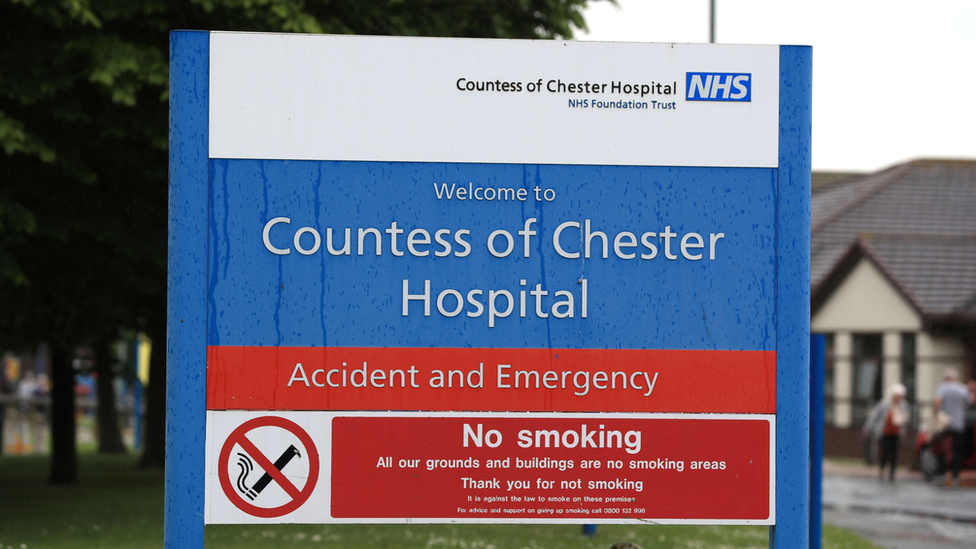Lucy Letby: Baby developed strange purple patches, trial hears
- Published

Lucy Letby is accused of murdering seven babies and trying to kill 10 others
A baby allegedly murdered by nurse Lucy Letby collapsed "in front of our faces" after developing "strange" purple patches, a doctor has told her trial.
Ms Letby is accused of injecting air into the bloodstream of the baby, referred to as Child E, at Countess of Chester Hospital in June 2015.
She has denied murdering seven babies and attempting to murder 10 others.
Dr David Harkness said he was standing at the foot of Child E's incubator when the sudden deterioration occurred.
Ms Letby, 32, is on trial at Manchester Crown Court accused of murdering Child E and attempting to murder his twin, Child F, the following day.
The twins had been born prematurely and Ms Letby, originally of Hereford, was the designated nurse caring for both boys, the jury was told.
Dr Harkness, a paediatric registrar, was on a night shift at the hospital on the night of Child E's death.
He was called to the neonatal unit after flecks of blood were found in the baby's vomit.
A gastro-intestinal bleed was thought to be the cause and treatments were given, including fluids and antibiotics.
Child E's vital signs including heart rate, oxygen levels and blood pressure were initially stable, the court heard, before further blood loss was noted.
The doctor's notes, shown to the court, record a sudden deterioration at 23:40 while he was in the room.
Ms Letby and another nurse were also on duty.
The notes also record a discolouration in the baby's abdomen and a fall in his blood perfusion.
Dr Harkness said: "This was a strange pattern over the tummy and abdomen, which didn't fit with the poor perfusion.
"The rest was still pink, but there were these strange purple patches.
"It certainly was unusual."

The nurse worked on the neonatal ward at Countess of Chester Hospital
Dr Harkness said he had seen this in Child A but had not seen it in any other baby since.
He said he and a colleague were standing at the end of the incubator discussing treatment plans when Child E collapsed "in front of our faces when we were stood there".
The court has previously heard how medics went on to use five doses of adrenaline and tried two rounds of resuscitation during a 45-minute battle to save the baby, beginning at 00:37 BST and ending at 01:23, when he was handed to his parents.
A blood transfusion was also given after the resuscitation efforts began, the court heard.
Ms Letby's defence lawyer Ben Myers KC called into question the consistency of Dr Harkness's descriptions of the skin discolouration and said "red patches" found on Child A were not noted for Child E.
'Serious mistake'
He accused the doctor of "putting details together" from various observations, which he denied.
He also put it to the doctor that it was a "serious mistake" not to have considered a transfusion for the baby much earlier.
Although it did not appear in his earlier notes, Dr Harkness said a transfusion would likely have been discussed throughout but the timing was important.
Mr Myers said the reaction to the bleeding was "far too slow wasn't it?"
The doctor replied: "I disagree."
Mr Myers also questioned the doctor's experience at the time and suggested he was "out of his depth" and should have called for support from an on-call consultant earlier.
Dr Harkness replied: "Knowing she was on site and available within several minutes I think that is wrong and disrespectful of my ability."
The trial continues.

Why not follow BBC North West on Facebook, external, Twitter, external and Instagram, external? You can also send story ideas to northwest.newsonline@bbc.co.uk
Related topics
- Published15 November 2022

- Published14 November 2022

- Published11 November 2022

- Published9 November 2022

- Published4 November 2022

- Published3 November 2022

- Published2 November 2022

- Published28 October 2022

- Published27 October 2022
